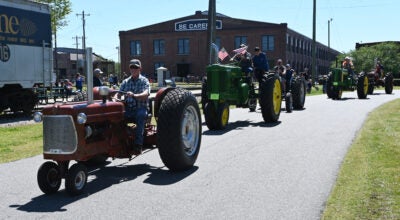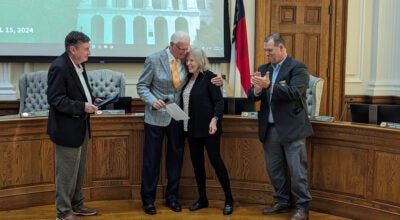When time stood still: It’s hard to shake those four days in November
Published 12:00 am Friday, November 22, 2013
SALISBURY — The decision was made not to turn on Salisbury’s downtown Christmas lights that evening, a Friday.
The Salisbury Post tore up its front page and put out an extra afternoon edition.
WSTP radio suspended its advertising and started playing only classical music, interrupted periodically with news updates.
Many kids in Rowan County schools learned about what happened from their principals’ announcements over school intercoms, in school auditoriums or from their teachers.
On Saturday, Mayor Louis Harrison issued a proclamation of grief. By Sunday, Post Editor Spencer Murphy spoke about “the kinship of grief” felt by all Americans:
“Its footsteps are heard everywhere. The look of amazed shock and disbelief is as apparent at Innes and Main as in Sandusky or Hollywood and Vine.”
Monday became the official day of mourning. Schools closed. Salisbury businesses were asked to shut down for an hour, from noon to 1 p.m.
The assassination 50 years ago today of President John F. Kennedy blind-sided everyone, becoming for the people of my generation a touchstone — one of those days where people remember where they were when they heard the news.
I was 6. Kennedy was the first president to whom I ever paid attention. He and Jacqueline Kennedy — Jack and Jackie — were young, seemingly the same age as my parents. They were always on television or in the pages of “Life,” the magazine I absorbed during visits to my grandmother’s house.
Even though I was a youngster, I recall Kennedy’s televised press conferences — maybe because they were in the afternoon and interrupted shows I may have wanted to watch after school.
He was the center of attention, likeable, able to be serious and statesman-like one moment, funny and humble the next. As a kid, you can recognize these things.
ggg
As I remember that Friday in 1963, the ladies from the school cafeteria rapped on my teacher’s classroom door and called her over.
The women huddled and whispered among each other in the back. Some of them were sniffing into tissue paper. They seemed to carry a grave secret.
My teacher returned to us shaken by some news, and it was from her we learned that President Kennedy had been shot and killed.
So began for me and millions of others the barrage of black-and-white images coming from our television sets at home.
I watched the delivery of Kennedy’s body back to Washington and the country’s transition to a new president, one who seemed so much older and grandfatherly than Kennedy.
On the Sunday morning after the shooting, I was in the living room with my dad, catching a glimpse of suspected assassin Lee Harvey Oswald as he was led through a hallway in Dallas, only to be shot in front of us by Jack Ruby.
My dad and I traded looks without saying anything. What had we just seen? It took a few moments of sorting out before realizing we had witnessed, with millions of others, a live homicide on television.
ggg
Then came Monday’s funeral and other things you can’t forget.
Jackie Kennedy, only 34 and dressed in black, kissing her husband’s casket in the Capitol Rotunda.
The riderless U.S. Army horse, “Black Jack,” with its empty cavalry boots turned backwards in the stirrups. The empty saddle holding a sword.
The flag-draped casket on a horse-drawn caisson. The stillness of the crowds. The clicking sound of hooves and the creaking wheels of the caisson.
Little John F. Kennedy Jr.’s salute to the casket. All the military precision of Kennedy’s pallbearers and the honor guard.
Mrs. Kennedy’s lighting of the eternal flame at Arlington National Cemetery. The three-mile, one-hour funeral procession to get there.
ggg
Those four days in November — from news of the assassination through the Monday funeral in Washington — changed us, as children and as a country. It’s probably why we do countless anniversary stories, even 50 years now after the fact.
We came to think of the assassination as the loss of an age of innocence and hope, ushering in the years when we had to confront uncomfortable things, such as racial discrimination, the Vietnam War and more assassinations.
We dwelt on everything about Kennedy’s two years and 10 months as president. Those days fed to us as Camelot were really, of course, what most presidencies are — a mix of good and bad.
Kennedy set us onto the path of putting a man on the moon by the end of the decade. He established the Peace Corps. He stood up to Soviet Premier Nikita Krushchev during the Cuban missile crisis and over American rights of access in communist-surrounded Berlin.
But he also brought the world to the brink of a nuclear war and put himself behind an ill-fated Bay of Pigs invasion aimed at overthrowing Cuba’s Fidel Castro.
Kennedy seemed lukewarm at first in helping the Freedom Riders down South, and he miscalculated greatly what was happening in Vietnam and increased our military presence there.
We learned over the years to come of Kennedy’s reckless personal behavior in office and how he suffered through intense physical pain with his back, while also hiding his Addison’s disease.
ggg
And we also became obsessed these past 50 years with the assassination itself. So many terms and phrases are imprinted on our collective psyches.
Dealey Plaza. The grassy knoll. The Texas Book Depository. The motorcade. Oswald. Ruby. The Zapruder film. The Warren Commission. Conspiracy.
Many people persisted with the theory Camelot’s king could not have been killed by a mere peasant, acting on his own.
John F. Kennedy would be 96 today, but those four days in November froze him in our minds as the young king of Camelot.
To the people younger than 55 out there, forgive us our JFK preoccupation over all of these years.
The lesson we all seemed to learn back then was a fifth day finally came.
Here, WSTP returned to its regular programming. Students went back to school. The Christmas lights came back on.
But wherever we were, from Salisbury to Sandusky, we all felt a little older.
Contact Mark Wineka at 704-797-4263,or mwineka@salisburypost.com.




